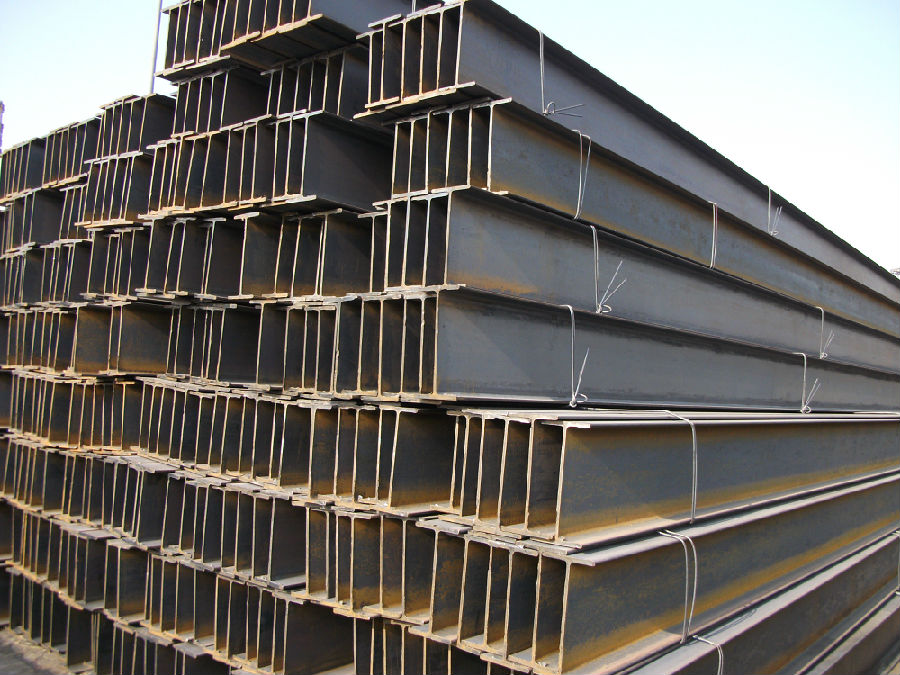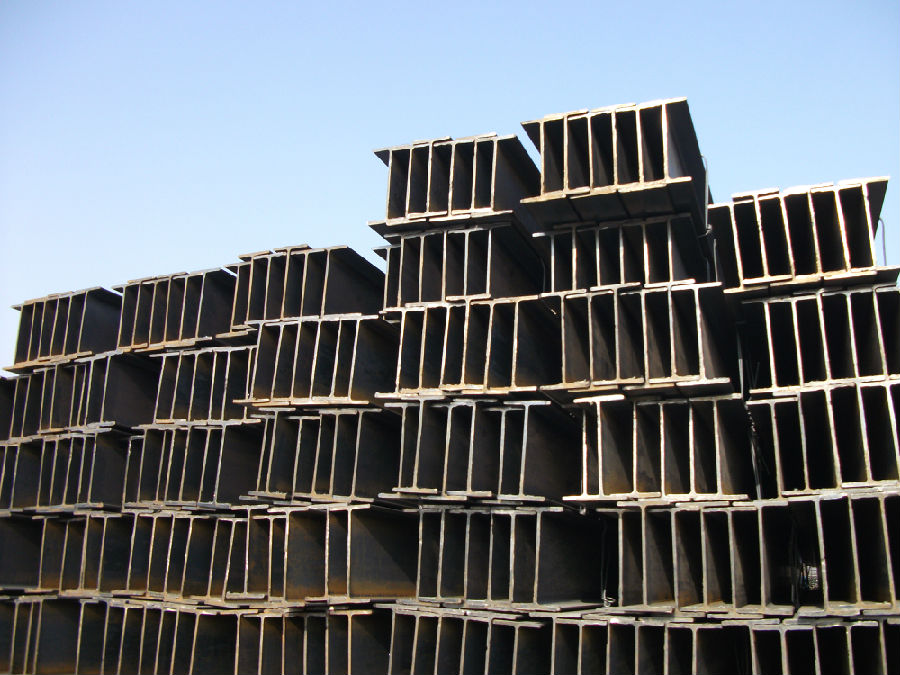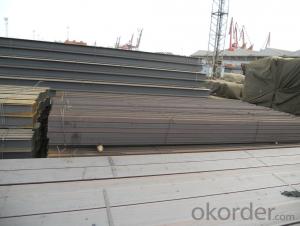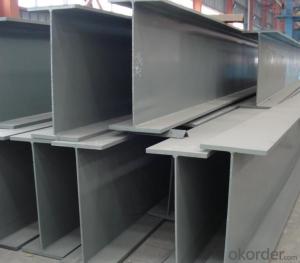Hot Rolled Steel JIS Standard H-beam Bar
- Loading Port:
- Shanghai
- Payment Terms:
- TT or LC
- Min Order Qty:
- 25 m.t.
- Supply Capability:
- 1000 m.t./month
OKorder Service Pledge
OKorder Financial Service
You Might Also Like
Product Description:
OKorder is offering Structural Steel H-beam JIS Standard at great prices with worldwide shipping. Our supplier is a world-class manufacturer of steel, with our products utilized the world over. OKorder annually supplies products to European, North American and Asian markets. We provide quotations within 24 hours of receiving an inquiry and guarantee competitive prices.
Product Applications:
Commercial building structure ;Pre-engineered buildings; Machinery support structure; Prefabricated structure; Medium scale bridges; Ship-building structure. etc.
Product Advantages:
OKorder's Structural Steel H-beam JIS Standard are durable, strong, and resist corrosion.
Main Product Features:
· Premium quality
· Prompt delivery & seaworthy packing (30 days after receiving deposit)
· Corrosion resistance
· Can be recycled and reused
· Mill test certification
· Professional Service
· Competitive pricing
Product Specifications:
1. Standard: JIS
2. Grade: SS400
3. Length: 12m
4. Invoicing on theoretical weight or actual weight as customer request
5.Payment: TT or L/C
6. Sizes:
H x B
(mm)
| T1 | T2 | JIS Weight
(kg/m)
| GB Weight
(kg/m)
|
100*100 | 6 | 8 | 16.9 | 17.2 |
125*125 | 6.5 | 9 | 23.6 | 23.8 |
150*75 | 5 | 7 | 14 | 14.3 |
148*100 | 6 | 9 | 20.7 | 21.4 |
150*150 | 7 | 10 | 31.1 | 31.9 |
175*90 | 5 | 8 | 18 | 18.2 |
175*175 | 7.5 | 11 | 40.4 | 40.4 |
198*99 | 4.5 | 7 | 17.8 | 18.5 |
200*100 | 5.5 | 8 | 20.9 | 21.7 |
194*150 | 6 | 9 | 29.9 | 31.2 |
200*200 | 8 | 12 | 49.9 | 50.5 |
248*124 | 5 | 8 | 25.1 | 25.8 |
250*125 | 6 | 9 | 29 | 29.7 |
244*175 | 7 | 11 | 43.6 | 44.1 |
250*250 | 9 | 14 | 71.8 | 72.4 |
298*149 | 5.5 | 8 | 32 | 32.6 |
298*201 | 9 | 14 | 65.4 | |
300*150 | 6.5 | 9 | 36.7 | 37.3 |
294*200 | 8 | 12 | 55.8 | 57.3 |
300*300 | 10 | 15 | 93 | 94.5 |
346*174 | 6 | 9 | 41.2 | 41.8 |
350*175 | 7 | 11 | 49.4 | 50 |
340*250 | 9 | 14 | 78.1 | 79.7 |
350*350 | 12 | 19 | 135 | 137 |
400*200 | 8 | 13 | 65.4 | 66 |
390*300 | 10 | 16 | 105 | 107 |
400*400 | 13 | 21 | 172 | 172 |
446*199 | 8 | 12 | 65.1 | 66.7 |
450*200 | 9 | 14 | 77.9 | 79.5 |
440*300 | 11 | 18 | 121 | 124 |
496*199 | 9 | 14 | 77.9 | 79.5 |
500*200 | 10 | 16 | 88.2 | 89.6 |
488*300 | 11 | 18 | 125 | 129 |
596*199 | 10 | 15 | 92.5 | 95.1 |
600*200 | 11 | 17 | 103.4 | 106 |
588*300 | 12 | 20 | 147 | 151 |
700*300 | 13 | 24 | 182 | 185 |
800*300 | 14 | 26 | 207 | 210 |
900*300 | 16 | 28 | 240.1 | 243 |
Usage & Applications of Hot Rolled Steel H-beam For Sale
Commercial building structure ;Pre-engineered buildings; Machinery support structure; Prefabricated structure; Medium scale bridges; Ship-building structure.etc.
Packaging & Delivery of Hot Rolled Steel H-beam For Sale
1. Packing: it is nude packed in bundles by steel wire rod
2. Bundle weight: not more than 3.5MT for bulk vessel; less than 3 MT for container load
3. Marks:
Color marking: There will be color marking on both end of the bundle for the cargo delivered by bulk vessel. That makes it easily to distinguish at the destination port.
Tag mark: there will be tag mark tied up on the bundles. The information usually including supplier logo and name, product name, made in China, shipping marks and other information request by the customer.
If loading by container the marking is not needed, but we will prepare it as customer request.
4. Transportation: the goods are delivered by truck from mill to loading port, the maximum quantity can be loaded is around 40MTs by each truck. If the order quantity cannot reach the full truck loaded, the transportation cost per ton will be little higher than full load.
5. Delivered by container or bulk vessel
Production flow of Hot Rolled Steel H-beam For Sale
Material prepare (billet) —heat up—rough rolling—precision rolling—cooling—packing—storage and transportation


FAQ:
Q1: Why buy Materials & Equipment from OKorder.com?
A1: All products offered byOKorder.com are carefully selected from China's most reliable manufacturing enterprises. Through its ISO certifications, OKorder.com adheres to the highest standards and a commitment to supply chain safety and customer satisfaction.
Q2: How do we guarantee the quality of our products?
A2: We have established an advanced quality management system which conducts strict quality tests at every step, from raw materials to the final product. At the same time, we provide extensive follow-up service assurances as required.
Q3: How soon can we receive the product after purchase?
A3: Within three days of placing an order, we will begin production. The specific shipping date is dependent upon international and government factors, but is typically 7 to 10 workdays.
Q4: What makes stainless steel stainless?
A4: Stainless steel must contain at least 10.5 % chromium. It is this element that reacts with the oxygen in the air to form a complex chrome-oxide surface layer that is invisible but strong enough to prevent further oxygen from "staining" (rusting) the surface. Higher levels of chromium and the addition of other alloying elements such as nickel and molybdenum enhance this surface layer and improve the corrosion resistance of the stainless material.
- Q:Can steel H-beams be used in temporary supports during construction?
- Yes, steel H-beams can be used in temporary supports during construction. Steel H-beams are commonly used in construction due to their strength and load-bearing capabilities, making them suitable for temporary support structures.
- Q:Can steel H-beams be used for composite structures?
- Certainly, composite structures can utilize steel H-beams. Composite structures typically involve the integration of diverse materials, like steel and concrete or steel and fiberglass, which work in harmony to create a more robust and effective structure. Steel H-beams are frequently employed as a supportive component in composite structures owing to their exceptional strength-to-weight ratio and capacity to withstand substantial loads. By combining steel H-beams with materials such as concrete or fiberglass, a composite structure can be formed that capitalizes on the unique properties of each material. While steel H-beams provide essential structural support, the composite materials contribute additional strength, durability, and other desirable attributes. In essence, the incorporation of steel H-beams in composite structures allows for the development of versatile and efficient structures that can fulfill a range of engineering and architectural specifications.
- Q:How do steel H-beams contribute to the overall natural light penetration in a building?
- The contribution of steel H-beams to the overall natural light penetration in a building is indirect. H-beams primarily serve the purpose of providing structural support and stability to the building's framework. However, the way in which H-beams are designed and positioned within the building can have an impact on the amount of natural light that enters. Architects and engineers often strategically incorporate large windows, skylights, or other openings in their building designs to allow for the entry of natural light. When H-beams are included in the structure, they are typically placed in areas that do not obstruct the placement of windows or other light openings. By properly positioning the H-beams, architects can ensure that they do not block the path of natural light from entering the building. This allows for an ample amount of light to penetrate through the windows and other openings, brightening the interior spaces. Furthermore, steel H-beams are renowned for their strength and ability to support heavy loads. This allows architects to design larger and wider windows without compromising the structural integrity of the building. The use of H-beams in the construction process facilitates the creation of open and airy spaces that maximize the entry of natural light. In conclusion, while steel H-beams themselves do not directly contribute to the penetration of natural light, their correct placement and structural support enable architects to design buildings with more extensive windows and openings, ultimately enhancing the overall natural light penetration throughout the space.
- Q:What is the maximum length of a steel H-beam that can be manufactured?
- The maximum length of a steel H-beam that can be made depends on various factors, including the manufacturing process, transportation limitations, and practical constraints. Concerning the manufacturing process, steel H-beams are typically produced in set lengths, which can vary depending on the specific steel mill or manufacturer. These standard lengths typically range from 20 to 60 feet (6 to 18 meters). However, it is worth noting that longer lengths can often be requested or fabricated based on specific project requirements. Transportation restrictions also play a significant role in determining the maximum length of a steel H-beam. The beam's length must be able to fit within the constraints of transportation methods such as trucks, trains, or ships. Each of these transportation methods has its own size limitations, and going beyond these limits may necessitate special arrangements, permits, or even partial disassembly of the beam. Lastly, practical limitations must be considered when determining the maximum length of a steel H-beam. Lengthier beams can pose challenges in terms of handling, maneuvering, and installation at construction sites. The weight and size of the beam can make transportation and lifting more difficult, potentially requiring specialized equipment or additional manpower. In conclusion, while there are standard lengths for steel H-beams, the maximum length that can be manufactured is influenced by the manufacturing process, transportation restrictions, and practical considerations. Custom orders, transportation logistics, and practical limitations all contribute to determining the maximum length of a steel H-beam.
- Q:What are the different connection methods used for steel H-beams?
- There are several different connection methods used for steel H-beams, depending on the specific requirements and structural needs of the project. Some of the most common connection methods include: 1. Welding: Welding is a popular method used to connect steel H-beams. It involves melting the edges of the beams and fusing them together using a welding electrode. This method provides a strong and durable connection, ensuring structural integrity. 2. Bolting: Bolting is another commonly used connection method for steel H-beams. It involves using bolts and nuts to secure the beams together. This method allows for easy disassembly and reassembly, making it a flexible option for various construction projects. 3. Riveting: Riveting is an older but still occasionally used method for connecting steel H-beams. It involves drilling holes in the beams and then using rivets to secure them together. Although riveting is a time-consuming process, it provides a strong and reliable connection. 4. Adhesive bonding: Adhesive bonding is a modern connection method that involves using high-strength adhesives to bond steel H-beams together. This method offers several advantages, such as uniform stress distribution and corrosion resistance. However, it requires specialized knowledge and careful implementation. 5. Mechanical connectors: Mechanical connectors are designed specifically for connecting steel H-beams. These connectors, such as shear connectors or moment-resisting connections, provide a reliable and efficient means of joining beams together. They often involve the use of bolts or welds for added strength. Each connection method has its own advantages and considerations, depending on factors such as load-bearing requirements, ease of installation, and project timeline. It is crucial to consult with structural engineers and adhere to industry standards and codes to ensure the appropriate connection method is selected for steel H-beams in any given construction project.
- Q:How are steel H-beams used in bridge construction?
- Steel H-beams are a popular choice in bridge construction because of their strength, versatility, and cost-effectiveness. These beams are designed specifically to bear heavy loads and provide structural stability, making them ideal for building bridges. When constructing bridges, steel H-beams are primarily used as the main structural elements. They support the weight of the bridge deck and transfer the load to the bridge piers or abutments. The H-shape of these beams allows for even weight distribution and excellent load-bearing capabilities. Another advantage of steel H-beams in bridge construction is their flexibility in fabrication. They can be easily made to the required length and size, allowing engineers to design bridges of various spans and heights to suit different site conditions. Furthermore, steel H-beams offer a high strength-to-weight ratio. This means they can support heavy loads without being excessively bulky or heavy themselves. This advantage is particularly valuable for long-span bridges, where reducing the weight of the structure is important to minimize material and construction costs. In addition, steel H-beams have excellent durability and resistance to corrosion. This is crucial for bridges exposed to harsh weather conditions and environmental factors. The steel used in these beams is often treated with protective coatings or galvanized to enhance its longevity and prevent deterioration over time. In conclusion, steel H-beams are essential in bridge construction as they provide the necessary strength, versatility, and durability to support heavy loads and maintain the structural integrity of the bridge. Their use enables efficient and cost-effective bridge designs that can withstand the test of time.
- Q:What are the different types of connections used for steel H-beams to steel columns?
- There are several types of connections commonly used for steel H-beams to steel columns, including bolted connections, welded connections, and hybrid connections. Bolted connections involve using bolts to secure the beam to the column, while welded connections involve fusing the beam and column together using welding techniques. Hybrid connections combine both bolting and welding methods to provide added strength and stability. The choice of connection type depends on factors such as the load requirements, structural design, and construction preferences.
- Q:How do steel H-beams perform in high-temperature environments?
- Steel H-beams perform well in high-temperature environments due to their inherent properties and design. The structural composition of steel, combined with its high melting point, allows H-beams to maintain their strength and integrity even when exposed to elevated temperatures. One of the key factors contributing to their performance is the thermal conductivity of steel. Steel has excellent heat transfer properties, meaning it can effectively distribute and dissipate heat throughout its structure. This property helps prevent localized overheating and reduces the risk of deformation or failure in high-temperature conditions. Additionally, steel H-beams are often treated with fire-resistant coatings or insulation materials to further enhance their performance in high-temperature environments. These coatings or materials act as a barrier, protecting the steel from direct exposure to extreme heat and minimizing the effects of thermal expansion. Furthermore, the unique design of H-beams, with the flanges and web working together to provide structural support, adds to their ability to withstand high temperatures. The thick flanges and web of the H-beams help distribute the load and resist bending, even when exposed to elevated temperatures. It is important to note that the performance of steel H-beams in high-temperature environments can be influenced by various factors such as the duration and intensity of the heat exposure, as well as the specific grade and quality of the steel used. Therefore, it is crucial to consult with structural engineers and adhere to relevant building codes and standards to ensure the proper selection and installation of steel H-beams in high-temperature applications.
- Q:What are the common fabrication techniques used for steel H-beams?
- There are several common fabrication techniques used for steel H-beams, including hot rolling, welding, and cutting. Hot rolling is the primary fabrication technique used to produce steel H-beams. It involves heating a large steel billet and passing it through a series of rollers to shape it into the desired H-beam profile. This process allows for the creation of H-beams with consistent dimensions and excellent structural integrity. Welding is another important technique used in the fabrication of steel H-beams. It involves joining multiple steel plates or sections together to create the H-beam shape. Welding can be performed using various techniques such as arc welding, MIG welding, or TIG welding, depending on the specific requirements of the project. Welding helps to increase the strength and rigidity of the H-beam by creating a continuous and seamless connection between the different components. Cutting is also a common fabrication technique used for steel H-beams. It involves the removal of excess material to achieve the desired dimensions and shape. Cutting can be done using various methods such as sawing, shearing, or plasma cutting. This process allows for precise and accurate shaping of the H-beam, ensuring it meets the required specifications. Overall, these fabrication techniques play a crucial role in the production of steel H-beams, ensuring their structural integrity, dimensional accuracy, and quality.
- Q:Are steel H-beams suitable for structures with high humidity?
- Structures with high humidity are generally well-suited for Steel H-beams due to the durability and moisture resistance of steel. However, it is crucial to take into account the unique conditions and humidity level present in the structure. In instances of exceedingly high humidity or continuous exposure to moisture, additional precautions may be necessary to safeguard against corrosion and guarantee the prolonged lifespan of the H-beams. These precautions encompass the application of protective coatings or the utilization of stainless steel beams, as they possess enhanced corrosion resistance.
1. Manufacturer Overview |
|
|---|---|
| Location | |
| Year Established | |
| Annual Output Value | |
| Main Markets | |
| Company Certifications | |
2. Manufacturer Certificates |
|
|---|---|
| a) Certification Name | |
| Range | |
| Reference | |
| Validity Period | |
3. Manufacturer Capability |
|
|---|---|
| a)Trade Capacity | |
| Nearest Port | |
| Export Percentage | |
| No.of Employees in Trade Department | |
| Language Spoken: | |
| b)Factory Information | |
| Factory Size: | |
| No. of Production Lines | |
| Contract Manufacturing | |
| Product Price Range | |
Send your message to us
Hot Rolled Steel JIS Standard H-beam Bar
- Loading Port:
- Shanghai
- Payment Terms:
- TT or LC
- Min Order Qty:
- 25 m.t.
- Supply Capability:
- 1000 m.t./month
OKorder Service Pledge
OKorder Financial Service
Similar products
New products
Hot products
Related keywords





























